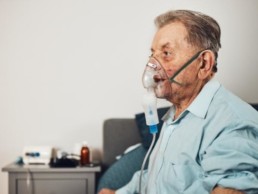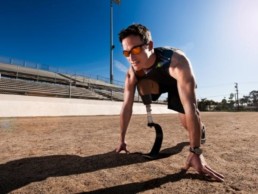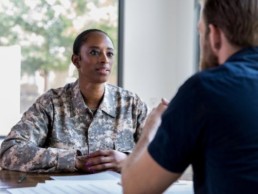What Women Veterans Need To Know About Breast Cancer

October is Breast Cancer Awareness Month! It is important to keep up to date with current events about the disease and get checked every so often by health professionals. Veterans, active service members, and our supporters should learn more about this problem that can be fatal to anyone. Studies show about 1 in 8 U.S women will develop breast cancer over the course of their lifetime1. Certain lifestyles bring a higher risk of getting cancer. Studies now show that if you’re a woman in the military, you are more likely to get breast cancer due to exposure to chemicals and radio emissions if your duties require you to work with either. Luckily, there are people who want to keep current and past service members aware of this and push for action to be able to get more accessible screenings while in the military. Purple Heart Foundation believes everyone should keep an eye on their health to prevent any illnesses such as Breast Cancer that can lead to death.
What Is Breast Cancer
It is important to understand at the basic level what breast cancer is and what to look out for. Breast cancer is a disease that occurs when changes take place in a person’s genes that control cell growth in the body. This mutation advances the multiplication of cells in your body with no control. When this mutation occurs in breast cells, it can form in different parts of the breast. This includes the fatty tissue, lobules, or ducts of the breast. Some symptoms of breast cancer include continuous pain in the breasts, redness of the skin on the breast, or rashes2. There are stages of breast cancer which define how big the tumor is and whether it is spreading. The stages are from 0-4. The evaluation by a doctor determines what stage the person is in. It is important to get checked and prevent cancer from spreading.
Service Members And Breast Cancer
Although both men and women can get breast cancer, it is more likely to occur in women. According to a study by the CDC, breast cancer is the second most common cancer in all women. The disease is estimated to be up to 40 percent higher in women veterans and service members than in the general population3. This is an alarming rate for women in uniform. Breast cancer for active-duty women is seven times higher compared to the average rate of fifteen other types of cancer for all service members4. One reason breast cancer affects service members and veterans is likely because of higher levels of stress, exposure to toxic chemicals from working industrial jobs, and other factors. Another reason is radio emissions, women that work as radio operators, electricians, and other jobs dealing with exposure to electromagnetic radiation are at a greater risk5. Veteran Kate Hendricks Thomas got a screening done at 38 years old and found out she had three different cancers. She says, “Now that I am a few years out, I tell everybody to get it checked. The enemy is lurking in our bodies6.” Doctors and women veterans are advocating for the younger demographic to get screened.
What Can Be Done?
The key is to be able to detect the disease as early as possible through regular health screenings and check-ups by health professionals. Early detection can lead to getting early treatment. You can also check for any abnormalities that may show up through a self examination. Currently in congress, there is action being taken to push access for military women to have wider access to mammograms. It is a proposal that would allow breast cancer screenings for women in the U.S. military. The good news is it has passed through the Senate this year. If the bill passes, The Department of Veterans Affairs will be required to screen women who have served in areas where there were burn pits. The bill is now in the U.S. House and up for consideration7. We are a step closer to ensuring veterans have preventative care to live long and healthy lives. This is a good step toward helping military servicewomen get the help they need, and deserve
The military community has a responsibility to help our women, active members, and veterans, because of their sacrifice for our country. They have put their bodies on the line, so we must assure that they get the help they need to live a long and healthy life.
_1 https://www.voice4vet.org/breast-cancer-your-va-rating/
_2 https://www.voice4vet.org/breast-cancer-your-va-rating/
_3 https://reporter.nih.gov/project-details/10009841
_4 https://cdmrp.health.mil/bcrp/pbks/bcrppbk2021.pdf
_5 https://www.usatoday.com/story/news/nation/2012/10/02/breast-cancer-troops/1608293 /
Recognizing Our Veterans This Mesothelioma Awareness Day
This September 26th marked the 17-year anniversary of Mesothelioma Awareness Day. This is a day devoted to spreading awareness about this rare and extremely aggressive form of cancer. What many do not know is that mesothelioma is one of the few non-genetic forms of cancer and is usually spoken in tandem with asbestos. Asbestos is the only known culprit of mesothelioma and was heavily used throughout the military from the early 1900s up until the 1980s. Unfortunately, its past use in the military has led to emerging mesothelioma cases today, with roughly 900 new mesothelioma diagnoses annually among our veteran population.
Exposure In The Air Force
For veterans of the Air Force, exposure to asbestos most likely happened on actual Air Force bases. Insulation, wall board, piping, plumbing, sealers, and adhesives were known to contain this carcinogen. Servicemen and women most at risk of exposure were the ones who lived on these bases with their families.
Planes used by the Air Force also contained asbestos in some parts, such as the heat shield, engine, and brake pads. Aircraft mechanics were put at risk as these parts began to wear down and fibers were released into the air. Secondhand exposure was also a risk, as asbestos fibers cling to the clothes. This means that mechanics could have been carrying asbestos off the job site, unknowingly exposing their families when they came home from work for the day.
Exposure In The Coast Guard
Those who served in the Coast Guard were mostly likely to come into contact with asbestos while on shipyards and on ships. Coast Guard Cutters were likely to be harboring asbestos in many different areas of the ship. Pump rooms, boiler rooms, sleeping quarters, and mess halls all could have had asbestos-containing materials (ACMs) present. The close quarters type of living on these vessels allowed for asbestos fibers to travel easily to other areas of the ship, potentially exposing everyone on board. The height of exposure for Coast Guard personnel was during World War II, where usage and production of asbestos was at its peak.
Exposure In The Army
Similar to the Air Force, Army personnel had a high risk of exposure when on Army bases. Insulation, floor tiles, roofing, and cement incorporated this carcinogenic mineral not only because of its fire-resistant qualities, but because it was so cheap. Off-site locations known as Army reserves were also prone to the usage of asbestos. In 2005, the Environmental Protection Agency (EPA) reported that there were still ACMs that needed to be abated from these locations.
Army vehicles also utilized asbestos in some parts that would experience high temperatures and friction. This posed a risk to Army mechanics whose job required them to repair brake pads, gaskets, and clutch plates on vehicles used in combat and transport.
Exposure In The Navy
Navy veterans are the most likely of all military personnel to develop an asbestos-related disease. This is due to the fact that asbestos was most heavily used among this branch of the military. Cruisers, destroyers, aircraft carriers, submarines, and more were often built with ACMs. Asbestos was primarily used in the insulation of these vessels and was also favored because it does not deteriorate easily when in contact with water. The servicemen and women involved in the building, repairing, and retiring of these ships were the ones who most likely were exposed, as the ACMs would degrade overtime.
Exposure In The Marines
Much like the Navy and Coast Guard, veterans of the Marines were also put at risk by being on and working with ships. Marines are often aboard Navy ships being transported to and from conflict areas. While being transported, they carry out maintenance tasks the same as any Navy member would. These duties may involve repairing gaskets or removing insulation, which can disturb and release asbestos. Unfortunately, many of the high-risk ships used throughout World War II and the Vietnam War are still a part of the Navy’s fleet today.
Spreading Awareness
With mesothelioma continuing to affect so many veterans every year, the Purple Heart Foundation believes it is imperative to increase awareness of this disease. This cancer could be diagnosed less, or even disappear, if we are vigilant in protecting ourselves and our military population from asbestos exposure.
Traumatic Brain Injury and the Importance of Connection
Often referred to as the signature injury of the Iraq and Afghanistan wars, the prevalence of traumatic brain injury (TBI) among veterans is higher than it’s ever been. The most common cause of TBI among Operation Enduring Freedom and Operation Iraqi Freedom service members is injuries suffered from Improvised Explosive Devices, or IEDs, used extensively against Coalition Forces.
Many people who sustain a Traumatic Brain Injury recover completely. However, in severe cases, a traumatic brain injury can cause emotional and behavioral changes that can be difficult to understand and accept.
A traumatic brain injury affects the entire family and often results in financial challenges, job loss and isolation. In the United States, 1.7 million people sustain a TBI each year. Whether you have suffered a TBI or are caring for someone who did, understanding you’re not alone is critical, the best thing you can do is reach out.
Join a group
Meeting in person with other people with similar experiences can be cathartic. There are several places to find groups in your area.
Meetup.com has many brain injury and veteran meet ups across the country.
The Brain Injury Association of America has local chapters and various support groups throughout the U.S.
Share your story
When you can share your story and hear the stories of others, you realize there are people out there who understand what you’re going through, who can commiserate, or help put things in perspective. Luckily, the internet makes sharing easier than ever.
Brainline Military is an organization that serves the military community providing information, resources, and support for current and former service members and their families living with traumatic brain injury. Read the personal stories of military members living with TBI, and share your own.
A quick search for “Facebook TBI support group” turns up a handful of pages where you can connect on Facebook and be part of the conversation.
Get Informed
Knowing about traumatic brain injury—the symptoms, treatment options, and benefits you’re eligible for as a veteran or active duty military—will allow you to thrive, not just survive with this condition.
Take a look at our list of TBI resources.
Paralympics Rio 2016
This year’s Olympic games in Rio de Janiero, Brazil was full of exceeded expectations, excitement, and more. In addition to Simone Biles, Michael Phelps, and other Olympians, there were 19 servicemen and women who qualified for a position on the Team USA roster–15 active-duty personnel, 2 veterans, 1 Navy civilian, and 1 incoming midshipman to the Naval Academy, including Spc. Dan Lowe, Regine Tugade, and 2nd. Lt. Sam Hendricks.
Out of all 121 medals, Army Specialist Paul Chelimo received one of the 37 silver medals awarded. Chelimo, who was born in Kenya, won the silver in the men’s 5,000 meter run. After the race, he was informed by a television reporter that he was disqualified from the race for infringement in another athlete’s lane, but the ruling was later overturned. Chelimo ran his best time of 13 minutes, 3.94 seconds, right behind Great Britain’s Mo Farah.
Chelimo was a part of the U.S. Army World Class Athlete Program, which he credits for being the reason he was able to compete in Rio, “I’m only here because of these Army Soldiers,” Fanning said. “That’s the reason I’m part of this delegation. But it was fun for the entire delegation to have an extra reason to cheer, not just for the United States but for the Army, so they were screaming loudly for him: ‘Who’s your Soldier? Who’s your Soldier?’”
Chelimo’s next tour will not be overseas with fellow soldiers, but throughout the United States as a trainer with the World Class Athlete Program, inspiring the youth in this country to follow their dreams.
With the Olympics at a close, it’s time to turn our attention to the 15th Paralympic Games, which will also be held in Rio. Of the Paralympians competing, there are 20 soldiers, six Marines, three sailors, and one airman across the 23 sports being showcased.
In addition to Brad Synder, a sailor who lost his eyesight in Afghanistan and holds the world record for the blind 100-meter freestyle, there is Anthony McDaniel competing in Para Rugby and Elizabeth Marks, competing in Para Swimming, among other athletes and veterans. McDaniel lost his legs and left hand in 2010 from an improvised explosive device while serving as a Marine in Afghanistan and Marks suffered severe hip injuries while an Army combat medic in Iraq in 2010, which left her with no sensation in her left leg.
McDaniel said back in 2014 that adaptive sports helped give him a sense of tranquility after spending more than a year in rehab following the IED explosion in August 2010, “It’s just been helping me stay focused and positive,” McDaniel said. “It keeps me out and active every day.”
Marks told ESPN that the medals she earns in her competitions are not the end game–to her, the process of competing is more gratifying and thinks back to helping others during her time as a combat medic, “When I step onto the blocks, I never think, ‘I want to win,’” she says. “I think, ‘I want to pour all of myself into this race because there are people who can’t physically, mentally or emotionally, do that.’ So it’s my way of performing for them.”
The Paralympics are now days away from the start of the 15th Paralympics. It runs from September 7-18. We salute these servicemen and women and are excited to see how they compete and represent the United States and their respective military branches.
The Purple Heart Foundation is committed to assisting not just the Veterans of the Paralympics, but all veterans who have served our country. Show your support for these brave men and women by making a one-time or monthly pledge to ensure Veterans continue to get the support and benefits they deserve by clicking here.
From Deployment to Employment: How to Adjust to a Civilian Work Environment
Transitioning from military service to a rewarding career can feel like a daunting undertaking. The work environment and requirements are usually pretty different. What made you successful in the military may not work as well or could even be counterproductive in civilian life.
Many veterans have trouble coping with this adjustment for several reasons:
- The lower stakes lead to boredom.
- The lack of straightforward rules and missions can cause confusion and anxiety.
- Survival behaviors learned during combat, like a flight or fight response, are counter-productive in a work environment.
- Stress and painful memories from deployment can make it difficult to concentrate and remember important information.
- Military skills don’t always translate to a new work environment.
But the structure and discipline you mastered during your military service can also help you succeed in a civilian work environment. Here are a few things to remember:
Focus on your health.
- See a doctor when necessary and only take medications as prescribed.
- Stay away from unhealthy foods (high fat, high sugar).
- Don’t use non-prescribed drugs or drink alcohol excessively.
- Keep a routine—get enough sleep, exercise regularly, eat at the same time each day.
Learn and practice communication skills.
- Maintain polite and friendly communication with co-workers
- Ask for help about talking about deployment with colleagues
- Learn the appropriate ways to handle conflict and criticism, taking into account the culture of your workplace.
Practice organization
- Keep you workspace neat
- Make task lists
- If you have trouble staying focused, write your thoughts in a journal or notebook.
Create your own structure
- Assess your values and make a list.
- Determine the ways your job fits with your values.
- To identify your values, ask yourself questions like:
- What kind of an employee do I want to be? Hard-working? Dependable? A trustworthy officer?
- What parts of work are important to me? Using and building my skills? Fixing problems? Leading a team of people?
- What do I like about my current job? The way people treat each other? The feeling of accomplishment? Good benefits?
- How does this job fit with serving my country?
- Set long-term goals, like an ideal future position or promotion, and then set short-term goals that will help you achieve them.
- Stay current on training and the technology used in your field.
If you are looking for some training, check out Purple Heart’s Veterans Vocational Technical Institute.
If you want to go back to school and complete an undergraduate degree, learn about Purple Heart scholarships.
For career counseling or other services, find a National Service Officer near you.
Resources:
TurboTAP (Transition Assistance Program)
Veterans’ Employment and Training Services
Military.com Veteran Employment Center
Mesothelioma Awareness Day: How This Disease Continues to Impact Veterans
Every 26th of September, Mesothelioma Awareness Day (MAD) is recognized as a day to spread information about this rare disease and educate people about the dangers of its only known cause, asbestos exposure. Of the nearly 3,000 Americans diagnosed with mesothelioma each year, 30 percent of this total are veterans. It is important that we acknowledge the veteran population affected by this disease and continue efforts towards finding a cure.
What is Mesothelioma?
Mesothelioma is a form of cancer that primarily affects the lining of the lungs, but can also be present in the lining of the abdomen and heart. Due to its prolonged latency period, symptoms of this disease typically do not arise for nearly 10 to 50 years. When symptoms do begin to appear, oftentimes, the disease has already progressed to an advanced stage, making treatment options extremely limited.
Historically, the cause of mesothelioma cancer has been linked to asbestos exposure. Asbestos is a naturally occurring mineral that was often used in materials prone to heat and friction. When asbestos is disturbed, airborne fibers have the ability to be inhaled or ingested, gaining access to our internal organs. These fibers lay dormant within our bodies where they cause inflammation and scarring, leading to the development of tumors.
For those diagnosed with mesothelioma, the prognosis is most often very poor. Patients who are diagnosed at an earlier stage are given between 16 to 21 months to live post-diagnosis, which is a limited amount of time to pursue treatment.
How Are Veterans Affected?
Service men and women of our military are susceptible to asbestos exposure as a result of mass historic use of asbestos-products. While there has been a decline in asbestos usage and stricter regulations, asbestos may still be present on military bases, naval ships, and aircraft equipment. Because of this, there is a steady diagnosis rate amongst veterans. This will remain unchanged until asbestos is completely banned in the United States or the government issues a mandate for all asbestos to be removed from military locations.
Those who have served our country between 1920 to 1980 are at the highest risk of developing an asbestos-related disease, as this was the height of asbestos usage. Locations such as the sleeping barracks of ships used in the Navy were tight and limited, allowing for a high concentration of fibers to be present if asbestos was disturbed. Other branches that are affected by asbestos include the Air Force, Army, Coast Guard and Marines through asbestos materials used in things such as aircraft braking systems, military vehicles, and fireproofing for ships.
An additional risk factor that should be kept in mind is the use of asbestos in other countries. Members of our military can also be exposed while on deployment and stationed in areas that are war-torn, and as a result, have created large amounts of debris and rubble.
Across borders, many older buildings and homes on United States bases could be harboring asbestos-containing materials, such as roofing and flooring tiles. While it is difficult to avoid exposure because asbestos fibers are invisible to the naked eye, with the right protective equipment and knowledge, we can work to keep our military safe from these asbestos-related diseases.
Symptoms & Detection
Veterans that believe they may have been exposed to asbestos should receive checkups frequently and monitor their health closely. Symptoms of mesothelioma often mimic those of other less serious illnesses and should be evaluated no matter how seemingly minor. Some of the symptoms are as follows:
- Abdominal swelling
- Breathing difficulties
- Muscle Weakness
- Chest pain
- Coughing
Testing such as X-rays and CT scans can provide insight into underlying symptoms and help identify any abnormalities. Blood tests should also be performed regularly to see if there is an overabundance of mesothelin present in the blood, which may hint at malignancy. It is vital to monitor symptoms immediately. This will allow for the best chance of survival and successful treatment if the disease is caught early.
What to do if You’re Diagnosed
If you are diagnosed with mesothelioma, the next step is to understand your treatment options. It is important to research and connect with an oncologist that specializes in mesothelioma cancer, as they will be able to provide you with the latest and most effective treatments specific to your diagnosis. Cancer treatment costs can oftentimes be burdensome to families, and when diagnosed with mesothelioma, there is typically a party that is liable for the disease that you have developed. To manage these costs better, it is your right to seek legal action, as there are victim compensation funds set in place to ensure those who are affected by asbestos exposure receive the funding they deserve for their treatment.
How You Can Help
Mesothelioma is one of the lesser-known forms of cancer, receiving minimal coverage in mainstream oncology. With the support of others and by spreading awareness, this cancer will not only be diagnosed less, but a cure could be on the horizon. Through donating to the Purple Heart Foundation, the MOPH National Service Officer program will continue to help veterans fight for their VA benefits and receive much-needed care for injuries and illnesses, such as mesothelioma, that stem from service to our country.






